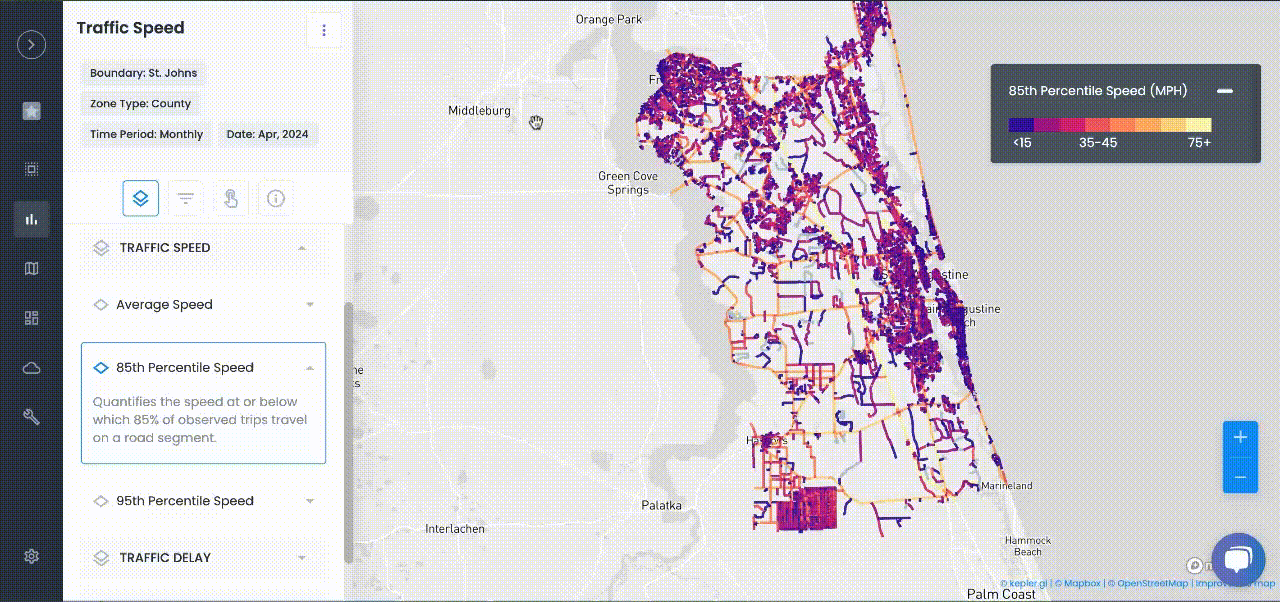
Transportation Planning
How to Use Roadway Segmentation Data for Better Asset Management
How roadway segmentation data helps cities manage assets better—using AI and GIS to prioritize repairs and streamline budgets
How roadway segmentation data helps cities manage assets better—using AI and GIS to prioritize repairs and streamline budgets.
City streets and highways are among a community’s most valuable assets. Managing these assets effectively requires detailed knowledge of road conditions and usage – not just at the citywide level, but down to individual road sections. This is where roadway segmentation data comes into play. By breaking roads into logical, manageable segments, planners and engineers can monitor each section’s condition and performance, leading to smarter maintenance plans and more efficient use of budgets.
What Is Roadway Segmentation Data?
Roadway segmentation data refers to the practice of dividing a road network into smaller segments, each defined by consistent characteristics or logical start and end points (often intersections). Instead of treating a long road as one monolithic asset, segmentation breaks it into pieces – for example, from one intersection to the next – each piece identified by a segment ID and associated with specific attributes (length, number of lanes, pavement type, etc.). This creates a granular inventory of the road network. Each segment can be analyzed and managed individually, which is crucial for pinpointing where repairs or upgrades are needed.
Segmentation ensures that data about the road is tied to the correct location. For instance, pavement condition ratings, traffic volumes, and speed limits are recorded per segment rather than for an entire road. Modern geospatial databases and GIS (Geographic Information Systems) rely on such segmentation to map and manage assets. In fact, roadway segments usually begin and end at intersections to create a topologically complete network. This means every segment connects logically, enabling route analysis and easy integration with other spatial data (like crash locations or traffic sensor data).
Why Segmenting Roads Improves Asset Management
Breaking roads into segments provides a more manageable framework for asset management. Here are key ways this data supports infrastructure maintenance and planning:
Pavement Condition & Maintenance Planning: By segmenting the network, agencies can assign a pavement condition rating to each road section and plan maintenance accordingly. This granularity identifies exactly which stretches are deteriorating and need attention. It also helps schedule resurfacing or repairs at optimal times for each segment, preventing over- or under-maintenance. In short, segmentation lets engineers apply the right fix to the right section at the right time.
Inventory Control: Roadway segmentation creates a detailed asset inventory. Officials know precisely how many miles of each road type they have (for example, how many segments of arterial vs. local roads) and the features each segment contains (lanes, sidewalks, surface type, etc.). This comprehensive inventory supports better budgeting and ensures nothing is overlooked. Modern tools even automate the surveying process – for instance, AI can scan an entire city’s roads via imagery and catalog every segment’s attributes.
Prioritizing Interventions with Segmented Data
One of the greatest advantages of segmentation is that it enables data-driven prioritization of maintenance. Each road segment can be tagged with key metrics – for example, its pavement condition rating, traffic volume, or crash history. Planners can compare segments using these factors (along with the road’s functional class or importance) to decide which sections need attention first. An arterial segment with heavy traffic and poor condition will naturally rank above a lightly-used street in decent shape.
In practice, pavement management programs do exactly this by assigning priority scores to segments based on condition and usage. This ensures that limited maintenance budgets go to the most critical needs first, rather than relying on guesswork or complaints. Segmented data brings clarity to the decision-making process, so agencies can justify why a particular stretch of road is scheduled for repair or why another can wait a bit longer.
Traditional Asset Management vs. Segmentation-Based Systems
It’s worth noting how far asset management has come. Traditional asset management often relied on broad, infrequent assessments and manual record-keeping. Agencies might have used paper maps or spreadsheets with road names and general conditions. Maintenance was frequently reactive – fixing things after they broke, or resurfacing entire roads based on subjective judgment. This approach made it hard to target specific trouble spots, and important data (like exact locations of pavement failures) could get lost in aggregation.
By contrast, segmentation-based asset management is proactive and precise. Staff can update and query the status of any road segment instantly on a map, instead of relying on infrequent field inspections. This shift saves time and money – tasks that once required sending crews to drive every street can now be done digitally.
Another difference is integration. Traditional approaches kept data in silos – one system for pavement, another for traffic, separate accident reports, etc. Segmented roadway data, especially when powered by modern platforms, is built to integrate multiple data sources.
For instance, it’s now feasible to link a road segment’s pavement condition with its traffic speed data and crash history all in one system. This holistic view was rarely attainable in older asset management, but it’s becoming standard practice in the era of smart cities.
Urban SDK’s AI-Driven, GIS-Ready Segmentation
Urban SDK is one platform providing roadway segmentation data as a service. Using high-resolution imagery and AI, Urban SDK automatically digitizes every road into GIS-ready segments with rich attributes (lane counts, widths, surface type, speed limit, functional class, etc.). This yields an up-to-date digital inventory of each road segment, eliminating months of manual surveying.
Because each segment is geo-referenced, Urban SDK’s data easily integrates with other datasets. Agencies can overlay crash statistics or traffic speeds onto the segmented map to identify correlations and problem areas. The platform continuously updates segment data, effectively turning static road information into a live feed of network performance.
Users can also import their own local data and merge it with Urban SDK’s segmentation – for instance, combining local pavement survey results with attributes like speed limits and road width provided by the platform. This AI-driven, GIS-ready segmentation allows cities to quickly leverage advanced data without having to build it all from scratch.
Best Practices and Use Cases
Many agencies have adopted roadway segmentation as a best practice in infrastructure management. Modern pavement management systems (PMS), from small towns to state DOTs, divide the road network into segments (sections) as the basis for tracking conditions and scheduling repairs. Managing by segment yields better outcomes than treating entire roads uniformly. Segmentation is also utilized in safety programs – for example, highway safety manuals suggest analyzing homogeneous road segments to pinpoint high-risk locations. The same principle of grouping similar stretches can improve asset maintenance decisions. Additionally, cities using GIS-based tools (like local government asset management software) rely on road segments to store maintenance history and plan work orders, underscoring how segmentation enables targeted management.
Key Benefits of Roadway Segmentation Data
Using roadway segmentation data for asset management provides many benefits:
Targeted Maintenance: Allows pinpointing specific road sections for repairs, so fixes are surgical rather than widespread, saving money.
Prioritized Investments: Supports ranking of road segments by need (condition, traffic, safety), ensuring limited budgets address the most critical segments first.
Integrated Data Analysis: Enables the combination of pavement, traffic, and safety data on the same segment for holistic decision-making.
Efficiency and Time Savings: Reduces the labor of manual inspections by leveraging digital data. Urban SDK can survey an entire network in a fraction of the time.
Conclusion
Roadway segmentation data is revolutionizing how cities manage their streets. By breaking the network into logical sections, public agencies can adopt a proactive, data-driven approach to maintaining infrastructure. From keeping pavement in good condition to optimizing resurfacing schedules and improving safety, segmented data makes asset management more precise and effective.
Urban SDK’s AI-driven, GIS-ready segmentation exemplifies how technology is making it easier to harness this approach – delivering up-to-date road inventories that integrate with traffic speeds, crashes, and more. For city planners, transportation engineers, and decision-makers, the message is clear: embracing roadway segmentation data leads to better asset management and, ultimately, better roads for the community.
FAQs
Q1: What is roadway segmentation data, and why is it important for cities?
Ans: Roadway segmentation data divides a road network into smaller segments, each identified with unique attributes (e.g., length, surface, lanes, condition) and typically bounded by intersections. Segmenting enables granular tracking of condition, traffic, and usage, supporting smarter maintenance and investment decisions.
Q2: How does segmentation improve pavement condition monitoring and maintenance planning?
Ans: Segmentation allows cities to assign and update pavement condition ratings per section, rather than for an entire road. This precision lets agencies target repairs, prioritize resurfacing schedules, and apply the right maintenance at the right place and time - minimizing both over- and under-maintenance.
Q3: How does roadway segmentation support targeted investment and budgeting?
Ans: By tagging each segment with relevant metrics (like condition, usage, or crash rates), planners can prioritize repairs and investments for the most critical needs first. This data-driven prioritization ensures limited budgets are used efficiently and transparently, maximizing public benefit.
Q4: What’s the difference between traditional and segmentation-based asset management?
Ans: Traditional practices often rely on broad assessments, subjective judgement, or infrequent updates, which lead to generalized and sometimes inefficient actions. Segmentation-based systems use real-time, digital data to track each road section individually, enabling proactive, precise, and integrated management with faster updates and fewer in-field visits.
Q5: How does Urban SDK automate roadway segmentation for modern asset management?
Ans: Urban SDK leverages AI and high-resolution imagery to digitize every street into GIS-ready segments with rich attributes. This platform continuously updates and integrates segment-level data (e.g., crash stats, speeds, surface type), enabling cities to maintain a “live” digital inventory that supports all asset management workflows.
Q6: Can segmented data be integrated with other metrics for holistic decision-making?
Ans: Yes - modern tools like Urban SDK and leading asset management platforms allow agencies to merge segment data with pavement, traffic, and safety records. This holistic approach links infrastructure needs, safety outcomes, and network performance for fully informed, cross-departmental planning.
Q7: What are the real-world benefits of using roadway segmentation data?Ans: Cities that adopt segmentation-based management report significant cost savings from targeted repairs, improved accountability with clear prioritization, minimized disruption through surgical interventions, and the ability to justify decisions to both funders and the public.

TRAFFIC ENFORCEMENT FEATURES
80% of citizen complaints
are a perception problem
Urban SDK provides precise hourly speed data to evaluate complaints and deploy resources efficiently for the greatest impact to public safety.
Urban SDK provides precise hourly speed data to evaluate complaints and deploy resources efficiently for the greatest impact to public safety.
Target Speeding
Identify hot spots, validate monthly speeding trends and monitor vulnerable areas like school zones.
Improve Safety
Crash and citations location information to compare speed trends month over month
Fast Response
Respond to citizen complaints sooner with address search and exportable reporting
Deploy Assets
Generate maps for traffic enforcement by time of day, location or division to deploy officers to known problem areas.
RESOURCES
Customer Success
See how public sector leaders succeed with Urban SDK.
WEBINAR
Identify speeding and proactively enforce issues
See just how quick and easy it is to identify speeding, address complaints, and deploy officers.







